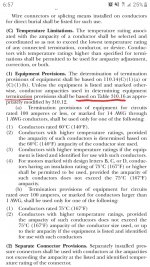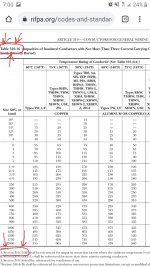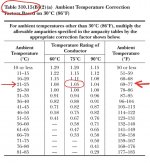James L
Senior Member
- Location
- Kansas Cty, Mo, USA
- Occupation
- Electrician
No, termination ampacity is not strictly a table look up. It is a reference to the ampacity of the conductor. And the ampacity of a conductor has two table lookups.That is an interesting question. I think it has been suggested that an equipment termination rated at 75C accepting a maximum wire size of, say, #3 Cu must be rated for 100A. Not sure about that.
Regardless, the point of the text in 110.14(C)(1) is that the termination ampacity check is a direct table lookup--you don't apply correction or adjustment factors. So at the termination you can't take credit for a lower than typical ambient temperature.
Cheers, Wayne
One table tells you the ampacity at 30 degrees Celsius
The other table gives you an adjustment factor, plus or minus, depending on ambient temperature.
And the adjustment of a 500 kcmil conductor in an ambient temperature below 78 degrees Fahrenheit is +5%
380 + 5% = 399 amps
A 500 kcmil lug rated at 75 degrees Celsius is good for 399 amps by default







 . I will just wait for people expert ones to respond to above cause I am lost and confused. However additional question that table also references more then 3 current carrying conductors how does that apply to terminations?
. I will just wait for people expert ones to respond to above cause I am lost and confused. However additional question that table also references more then 3 current carrying conductors how does that apply to terminations?